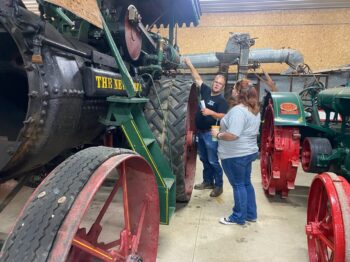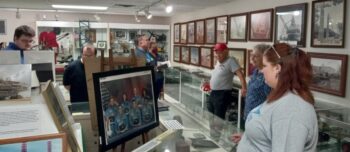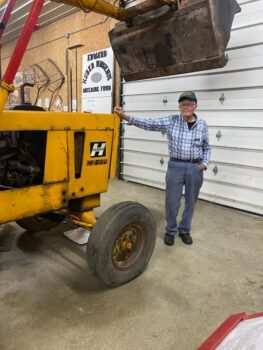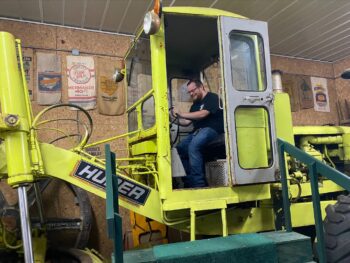
(Marion) The Huber Machinery Museum at the Marion County Fairgrounds takes visitors on a journey from the 1800s, when hay was cut by hand with a scythe, through more than 150 years of Marion history, changes, and innovation. Visitors see how a local inventor sparked the creation of tractors, steam shovels, threshers, and eventually the space crawler that took to NASA shuttles to the launch pad and then the moon.
“Things have changed so much in farming, construction, and industry. It’s important to preserve it and show future generations how it came about,” said volunteer Don Kiel, past president of the Huber Machinery Museum Board.
The museum recently gave a tour to a group of engineering students, faculty, and staff from Marion Technical College, inspiring inventors of the future.
Volunteer tour guide Karen Zucker described how Edward Huber revolutionized farming in 1863. His revolving hay rake allowed one person to do in three hours what normally took three people a full day to do by hand. His cousins convinced the 28-year-old to come to Marion in 1865 to produce the hay rakes because of the abundance of local hardwood.

Huber kept inventing, receiving more than 100 patents. He founded the Huber Manufacturing Company in 1874. He made the first working steam tractor engine as well as construction equipment. He helped found Marion Steam Shovel Company in 1884. The museum shows everything from drawings and models to full-sized threshers, steam shovels, and power shovels. A piece of the NASA crawler that was built in Marion is outside the museum. A video shows how the crawler taking Artemis I to the launch pad operates.
“It’s definitely amazing. When it comes to engineering stuff, I’m like a kid in a candy store!” said student Josh Dunn of Marion.

The museum invites visitors to see, touch and even sit in some of the local inventions. Everything in this museum is MarionMade!” exclaimed Kiel. “When you look at a machine, you have to visualize it. How many hours were put in, how many drawings made by hand, before each one was finally put together?”
The Marion Power Shovel company made farm equipment until World War II when the government told them to focus on road equipment to send overseas to make airstrips.
Retired engineer and museum volunteer Dan Stull worked for Marion Power Shovel for 13 years and then Fairfield Engineering for 30 years. Stull remembers doing live tests on machines in the 1960s.
“We had no safety gear back then. We put testing equipment on the shovel while it was operating. Today, OSHA [Occupational Health and Safety Administration] would shut that down,” said Stull.
Stepping through the museum is also a walk-through of Marion’s history.
“Mr. Huber was responsible for starting and bringing a lot of business to Marion and growing Marion,” Zucker said.
The Huber family brought a steam trolley to Marion. They founded a bank so employees could save and obtain home loans. They also founded the Opera House, Marion Milling Company, and Huber Milk. Prospect and West Center was known as the Huber block.

“I think Huber made Marion,” Zucker said.
A century before electric cars took off, Mrs. Huber had a two-seated electric car. Mr. Huber had several farms for research and development. Some were sold and are now home Tri-Rivers Career Center.
The Huber Machinery Museum at 220 East Fairground Street is open on Saturdays from 1 p.m. to 4 p.m. through November and by appointment. Tours are free though donations are welcome. Volunteers built the museum, donated the exhibits, and give their time to keep Marion’s history alive. For details, visit the Huber Machinery Museum Facebook page or call (740) 387-9233. Please be patient as the museum is run solely by volunteers.
The public is also invited to the Made in Marion Industrial Overview from local historian Dave Claborn on Thursday, Sept. 22 at 7 p.m. at Tri-Rivers.


















